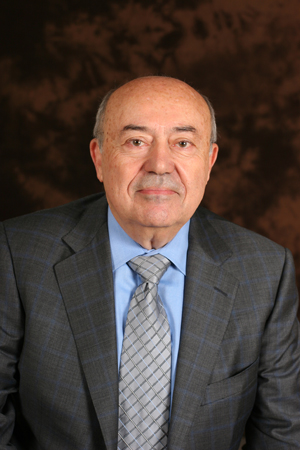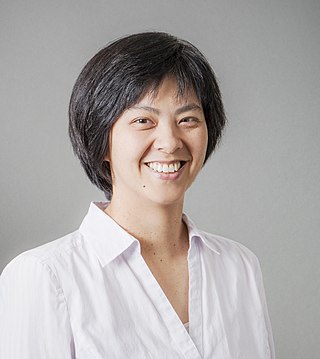Related Research Articles

The USC Information Sciences Institute (ISI) is a component of the University of Southern California (USC) Viterbi School of Engineering, and specializes in research and development in information processing, computing, and communications technologies. It is located in Marina del Rey, California.

Andrew James Viterbi is an Italian Jewish–American electrical engineer and businessman who co-founded Qualcomm Inc. and invented the Viterbi algorithm. He is the Presidential Chair Professor of Electrical Engineering at the University of Southern California's Viterbi School of Engineering, which was named in his honor in 2004 in recognition of his $52 million gift.

The USC Viterbi School of Engineering is the engineering school of the University of Southern California. It was renamed following a $52 million donation by Andrew J. Viterbi, co-founder of Qualcomm.

Adel S. Sedra is an Egyptian Canadian electrical engineer and professor.
The IEEE Robert N. Noyce Medal is a science award presented by the IEEE for outstanding contributions to the microelectronics industry. It is given to individuals who have demonstrated contributions in multiple areas including technology development, business development, industry leadership, development of technology policy, and standards development. The medal is named in honour of Robert N. Noyce, the co-founder of Intel Corporation. He was also renowned for his 1959 invention of the integrated circuit. The medal is funded by Intel Corporation and was first awarded in 2000.
Maja Matarić is an American computer scientist, roboticist and AI researcher, and the Chan Soon-Shiong Distinguished Professor of Computer Science, Neuroscience, and Pediatrics at the University of Southern California. She is known for her work in human-robot interaction for socially assistive robotics, a new field she pioneered, which focuses on creating robots capable of providing personalized therapy and care that helps people help themselves, through social rather than physical interaction. Her work has focused on aiding special needs populations including the elderly, stroke patients, and children with autism, and has been deployed and evaluated in hospitals, therapy centers, schools, and homes. She is also known for her earlier work on robot learning from demonstration, swarm robotics, robot teams, and robot navigation.

Massoud Pedram is an Iranian American computer engineer noted for his research in green computing, energy storage systems, low-power electronics and design, electronic design automation and quantum computing. In the early 1990s, Pedram pioneered an approach to designing VLSI circuits that considered physical effects during logic synthesis. He named this approach layout-driven logic synthesis, which was subsequently called physical synthesis and incorporated into the standard EDA design flows. Pedram's early work on this subject became a significant prior art reference in a litigation between Synopsys Inc. and Magma Design Automation.
Chung-Chieh Jay Kuo is a Taiwanese electrical engineer and the director of the Multimedia Communications Lab as well as distinguished professor of electrical engineering and computer science at the University of Southern California. He is a specialist in multimedia signal processing, video coding, video quality assessment, machine learning and wireless communication.
The Marie R. Pistilli Women in Engineering Achievement Award is issued annually since 2000 by the Design Automation Conference (DAC) to honor the outstanding achievements of women in Electronic Design Automation. It is named after the co-founder of DAC, Marie Pistilli. Originally named as the "Marie R. Pistilli Women in EDA Achievement Award", it is named the "Marie R. Pistilli Women in Engineering Achievement Award" since 2016.

Ellis Meng is the Shelly and Ofer Nemirovsky Chair of Convergent Biosciences and Professor of Biomedical Engineering and Electrical and Computer Engineering in the Viterbi School of Engineering at the University of Southern California, where she also serves as the Vice Dean of Technology Innovation and Entrepreneurship. Meng is highly decorated in the development of novel micro- and nanotechnologies for biomedical applications. In 2009, Meng was named on MIT Technology Review's "Innovators Under 35" List for her work on micropumps that deliver drugs preventing blindness, and she was listed on the 40 Under 40 List of the Medical Device and Diagnostic Industry (MDDI) in 2012.
Emily Mower Provost is a professor of computer science at the University of Michigan. She directs the Computational Human-Centered Artificial Intelligence (CHAI) Laboratory.
Maryam M. Shanechi is an Iran-born American neuroengineer. She studies ways of decoding the brain's activity to control brain-machine interfaces. She was honored as one of MIT Technology Review's Innovators under 35 in 2014, one of the Science News 10 scientists to watch in 2019, and a National Finalist for the Blavatnik Awards for Young Scientists in 2023. She is Dean's Professor in Electrical and Computer Engineering, Computer Science, and Biomedical Engineering at the USC Viterbi School of Engineering, and a member of the Neuroscience Graduate Program at the University of Southern California.
Mahta Moghaddam is an Iranian-American electrical and computer engineer and William M. Hogue Professor of Electrical Engineering in the Ming Hsieh Department of Electrical and Computer Engineering at the University of Southern California Viterbi School of Engineering. Moghaddam is also the president of the IEEE Antennas and Propagation Society and is known for developing sensor systems and algorithms for high-resolution characterization of the environment to quantify the effects of climate change. She also has developed innovative tools using microwave technology to visualize biological structures and target them in real-time with high-power focused microwave ablation.
Ingrid Verbauwhede is a professor at the COSIC Research Group of the Electrical Engineering Department, KU Leuven, where she leads the embedded systems team. She is a pioneer in the field of secure embedded circuits and systems, with several awards recognising her contributions to the field. She is member of the Royal Flemish Academy of Belgium for Science and the Arts since 2011. She is a fellow of IEEE.
Prathima Agrawal is an Indian-American computer engineer known for her contributions to wireless networking, VLSI, and computer-aided design. She is a professor emerita and the former Samuel Ginn Distinguished Professor of Electrical and Computer Engineering at Auburn University.
April S. Brown is an American electrical engineer and materials scientist in the Duke University Pratt School of Engineering, where she is a professor of electrical and computer engineering and the former John Cocke Professor of Electrical and Computer Engineering.
Leda Maria Lunardi is a Brazilian-American electrical engineer whose research concerns electronics, photonics, and optoelectronics. She is a professor of electrical and computer engineering at North Carolina State University.
Lynne Edwards Parker is Associate Vice Chancellor and Director of the AI Tennessee Initiative at the University of Tennessee. Previously, she was Deputy United States Chief Technology Officer and Founding Director of the National Artificial Intelligence Initiative Office at the United States' White House Office of Science and Technology Policy. She is an American roboticist specializing in multi-robot systems, swarm robotics, and distributed artificial intelligence.

Ewa Deelman is an American computer scientist specializing in distributed computing and cloud computing for applications in scientific computing. Her contributions include leading the design of the Pegasus scientific workflow management system, used by the LIGO scientific collaboration to detect gravitational waves from binary black holes. She is a research professor of computer science in the USC Viterbi School of Engineering, and a principal scientist at the Information Sciences Institute, both part of the University of Southern California.
Martin Ding Fat Wong is an American and Chinese computer scientist, electrical engineer, and university administrator. He is the Provost of the Hong Kong Baptist University (HKBU). Wong is known for his contributions to computer-aided design of integrated circuits.
References
- 1 2 3 4 "Alice C. Parker", Hall of Fame, NCSU Electrical and Computer Engineering, retrieved 2021-05-30
- 1 2 3 Conversations on Gender Equity: Alice Parker, Springer Nature, retrieved 2021-05-30
- ↑ Banegas, Diane E. (27 January 2009), "Synthetic Brains: Researchers study the feasibility of brains made from carbon nanotubes", Research news, National Science Foundation, retrieved 2021-06-03
- 1 2 3 4 5 6 7 8 9 10 11 12 Parker, Alice Cline (2020), "From Silicon to the Brain Using Microelectronics as a Bridge", in Parker, Alice Cline; Lunardi, Leda (eds.), Women in Microelectronics, Springer, pp. 173–186, doi: 10.1007/978-3-030-46377-9_12
- 1 2 3 "Alice Cline Parker", Viterbi Faculty Directory, USC Viterbi School of Engineering , retrieved 2021-06-03
- ↑ Alice C. Parker at the Mathematics Genealogy Project
- 1 2 3 Positions held, 31 July 1997, retrieved 2021-06-03
- ↑ IEEE Fellows directory, IEEE, retrieved 2021-05-30
- ↑ Ming Hsieh Department Professor Wins High Honor: The American Society of Engineering Education (ASEE) Sharon Keillor Award for 2009 goes to Alice Parker, USC Viterbi School of Engineering, 20 May 2009, retrieved 2021-06-03